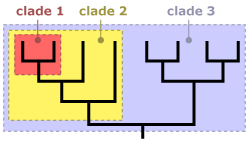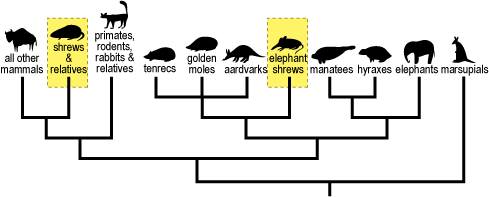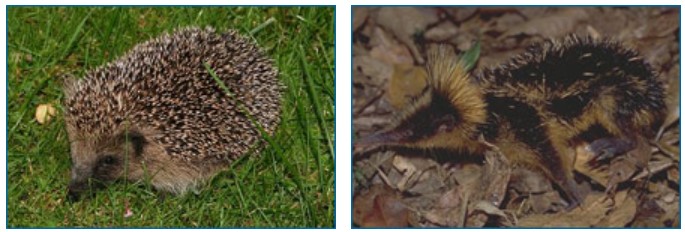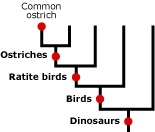
Not a shrew, that is. If you flipped through the newspaper’s Science and Technology section last month, you might have spotted this adorable imposter: big eyes, dainty feet, and a long, flexible snout resembling an anteater’s or an elephant’s. Formally known as Rhynchocyon udzungwensis, the giant elephant shrew made the news because it is fuzzy, photogenic, and new to science. While thousands of insect species are discovered each year, mammal species not yet in the scientific record (especially ones the size of a hefty squirrel, like R. udzungwensis) are a rarity. Most elephant shrew species were first described in the 1800s by scientists who classified them as shrews because of obvious physical similarities. But recent genetic evidence has confirmed that elephant shrews are not shrews at all…
Where's the evolution?
Just as people’s names are often based on their family history (and all the Higgenbothams in a small town are likely related), organisms’ names are based on their evolutionary history. Modern biologists group organisms according to the branches of the tree of life from which they evolved. A species accumulates all the names associated with all the branches that lead to its twig. So, for example, if we work our way backwards from the evolutionary twig belonging to the Common Ostrich (Struthio camelus), we find that it first joins the shoot belonging to all ostriches (Struthionidae), and that this shoot springs from the Ratite bird branch (Struthioniformes), which attaches to the bough belonging to all birds (Aves), which is itself just one offshoot of the dinosaur limb (Dinosauria)…and so on, all the way back to the root of the tree of life. Because the Common Ostrich is in each of these clades, it is given all of these names. It is an ostrich, a ratite, a bird, and a dinosaur.
A clade is a grouping that includes a common ancestor and all the descendents (living and extinct) of that ancestor. A clade may include many thousands of species or just a few. Using an evolutionary tree, it is easy to tell if a group of lineages forms a clade. Imagine clipping a single branch off the tree — all of the organisms on that pruned branch make up a clade. Clades are nested within one another — they form a nested hierarchy. Some examples of clades at different levels are marked on the trees below. Notice how clades are nested within larger clades.

Biologists name organisms according to their evolutionary history because this history is so informative. Since all organisms have inherited traits from their evolutionary ancestors, closely related organisms are likely to share many traits. So even if, for example, all we know about a newly discovered plant species is that it is some sort of yew, we can already make good guesses about other characteristics it might have — e.g., that it might contain chemicals useful in treating cancer, as some other yew species do.
Elephant shrews were originally classified as shrews (Soricidae) because of a superficial resemblance. However, in the late 1990s, when biologists began using detailed information on genetic sequences to reconstruct the family tree of mammals, the results were surprising. Elephant shrews were not closely related to shrews or to other mammal groups like rabbits, with which they had sometimes been lumped. Instead, the elephant shrew twig sprang from an unexpected branch of the tree: the aardvark, manatee, and elephant lineage!

This branch of the mammal tree is now known as the Afrotheria. Based on DNA, geologic, and fossil evidence, scientists think that this clade got its start around 100 million years ago. At that time, the continents that are now South America and Africa were breaking apart through tectonic action. The Afrotherian ancestor seems to have gotten isolated on Africa as that continent drifted away from other land masses. There, it diversified into the wide variety of Afrotherian species we see today — from elephants to the less familiar tenrecs and golden moles. Some of these lineages — elephants, hyraxes, dugongs, and manatees — later spread to other continents. Others — like the elephant shrew, tenrec, and golden mole — remained on their home continent.
Surprisingly, the homebodies in this African clade all have lookalikes from other continents! We’ve already seen that the elephant shrew looks enough like a regular shrew to have been mistaken for one. Along the same lines, the tenrec is a dead ringer for a hedgehog, and the golden mole could easily pass for a common garden mole — even though these counterparts trace their evolutionary histories to widely separated branches of the tree of life.


How did we wind up with distantly related pairs of lookalike species? The answer, again, relies on evolution — convergent evolution. When two different lineages face similar environments, constraints, or problems, natural selection may act on both lineages in the same way. This process could cause both lineages to evolve similar traits. For example, elephant shrews and regular shrews have similar lifestyles. Both forage in leaf litter and soil to find small invertebrates to eat. Hence, for both lineages, being near the ground and having long, sensitive noses with perceptive whiskers is advantageous. It seems likely that natural selection shaped both organisms in ways that favored these traits, causing them to evolve convergent body forms.
Traits in separate lineages that are similar, not because of common ancestry, but because of convergent evolution — like the long, sensitive noses of shrews and elephant shrews — are known as analogies. Likewise, the spiky fur of the tenrec and that of the hedgehog are analogies — as are the digging claws of moles and golden moles. Homologies, on the other hand, are structures that are similar because they were inherited from a common ancestor. The new species Rhynchocyon udzungwensis, for example, was identified as an elephant shrew by the homologies it shares with other elephant shrews — a long nose, large eyes, big ears, delicate limbs, and other anatomical features. And on a larger scale, elephant shrews were identified as Afrotherians, not by their trunk-like noses, but by the genetic homologies that revealed them to be the evolutionary cousins of their namesake, the elephant. When modern scientists classify and name organisms, there’s more to it than just superficial similarity. Biologists must distinguish analogous similarities from homologous similarities and base their classification on the homologies that represent deep evolutionary history — and that indicate how a newly discovered twig species attaches to the tree of life.
Primary literature:
- Murphy, W. J., Eizirik, E., O'Brien, S. J., Madsen, O., Scally, M., Douady, C. J., Teeling, E., Ryder, O. A., Stanhope, M. J., de Jong, W. W., and Springer, M. (2001). Resolution of the early placental mammal radiation using Bayesian phylogenetics. Science 294(5550):2348-2351.
- Nishihara, H., Satta, Y., Nikaido, M., Thewissen, J.G.M., Stanhope, M.J., and Okada, N. (2005). A retroposon analysis of Afrotherian phylogeny. Molecular Biology and Evolution 22(9):1823-1833. Read it »
- Rovero, F., Rathbun, G. B., Perkin, A., Jones, T., Ribble, D. O., Leonard, C., Mwakisoma, R. R., and Doggart, N. (2008). A new species of giant sengi or elephant-shrew (genus Rhynchocyon) highlights the exceptional biodiversity of the Udzungwa Mountains of Tanzania. Journal of Zoology 274(2):126-133. Read it »
- Springer, M. S., Cleven, G. C., Madsen, O., de Jong, W. W., Waddell V. G., Amrine, H. M., and Stanhope, M. J. (1997). Endemic African mammals shake the phylogenetic tree. Nature 388:61-64. Read it »
News articles:
- A summary of the discovery of the new elephant shrew species from the BBC
- A review of elephant shrew biology with photos and videos from the California Academy of Sciences
- An exhibit on elephant shrews from the Yale Peabody Museum
Understanding Evolution resources:
- Name at least three clades to which Rhynchocyon udzungwensis belongs.
- Why can’t Rhynchocyon udzungwensis be classified as a shrew?
- How did scientists figure out that elephant shrews were closely related to elephants?
- Review some background information on natural selection. Assume that the ancestor of elephant shrews had a short nose with short whiskers. Explain how elephant shrews evolved long, sensitive nose with perceptive whiskers. Make sure to include the concepts of variation, selection, and inheritance in your explanation.
- Shrews, elephant shrews, and elephants all have hair. Is this trait an example of a homology, analogy, or neither? Explain your reasoning.
- Do some research to find an example of convergent evolution not mentioned in the article above. Describe the analogous feature and how it might have evolved in the two lineages.
- Teach about evolutionary trees: In this web-based module for grades 6-12, students are introduced to cladistics, which organizes living things by common ancestry and evolutionary relationships.
- Teach about classification: In this activity for grades 9-12, students construct an evolutionary tree of imaginary animals (Caminalcules) to illustrate how modern classification schemes attempt to reflect evolutionary history.
- Teach about classification and convergent evolution: This research profile for grades 9-12 follows scientist Chelsea Specht as she pieces together the evolutionary history of tropical plants and their pollinators — and in the process, tries to figure out how to conserve endangered species.
- Rathbun, G. Elephant shrews or sengis: Biological synopsis. California Academy of Sciences. Retrieved February 25, 2008 from the California Academy of Sciences
- Murphy, W. J., Eizirik, E., O'Brien, S. J., Madsen, O., Scally, M., Douady, C. J., Teeling, E., Ryder, O. A., Stanhope, M. J., de Jong, W. W., and Springer, M. (2001). Resolution of the early placental mammal radiation using Bayesian phylogenetics. Science 294(5550):2348-2351.
- Nishihara, H., Satta, Y., Nikaido, M., Thewissen, J.G.M., Stanhope, M.J., and Okada, N. (2005). A retroposon analysis of Afrotherian phylogeny. Molecular Biology and Evolution 22(9):1823-1833.
- Rovero, F., Rathbun, G. B., Perkin, A., Jones, T., Ribble, D. O., Leonard, C., Mwakisoma, R. R., and Doggart, N. (2008). A new species of giant sengi or elephant-shrew (genus Rhynchocyon) highlights the exceptional biodiversity of the Udzungwa Mountains of Tanzania. Journal of Zoology 274(2):126-133.
- Springer, M. S., Cleven, G. C., Madsen, O., de Jong, W. W., Waddell V. G., Amrine, H. M., and Stanhope, M. J. (1997). Endemic African mammals shake the phylogenetic tree. Nature 388:61-64.

